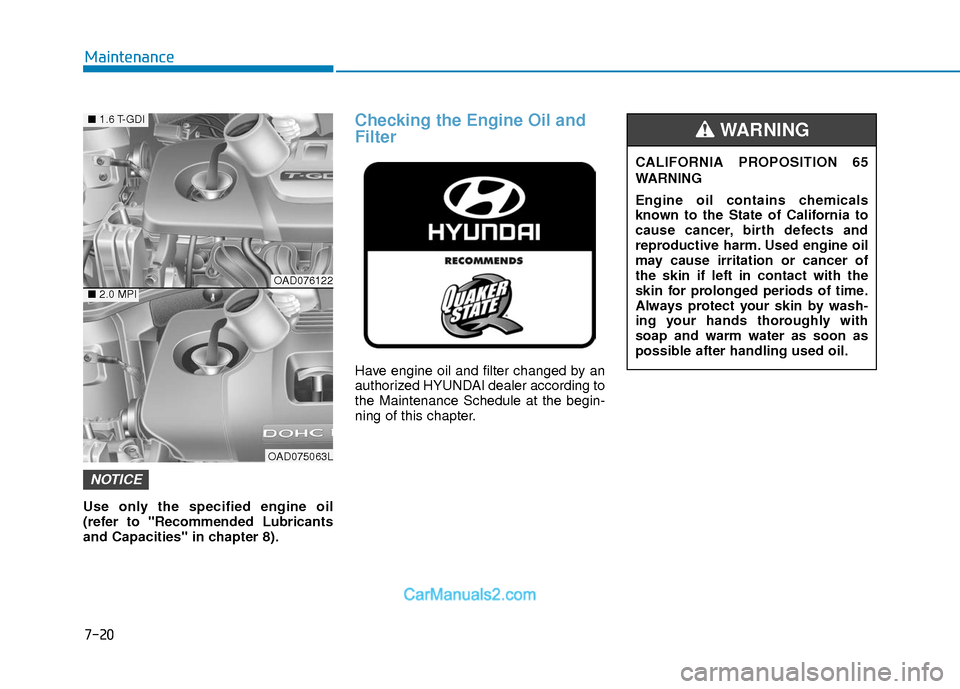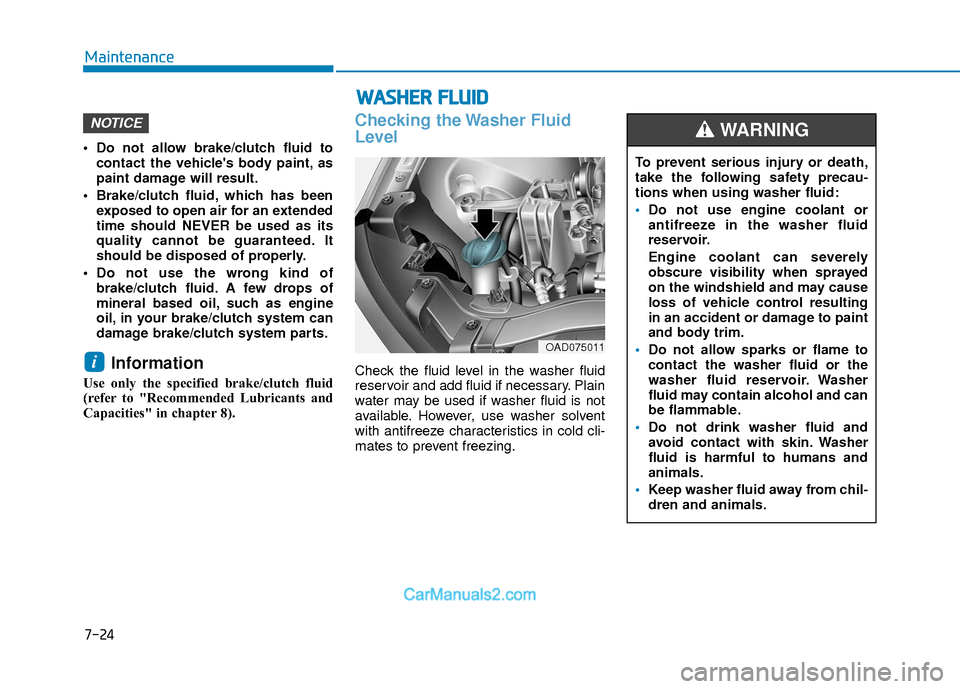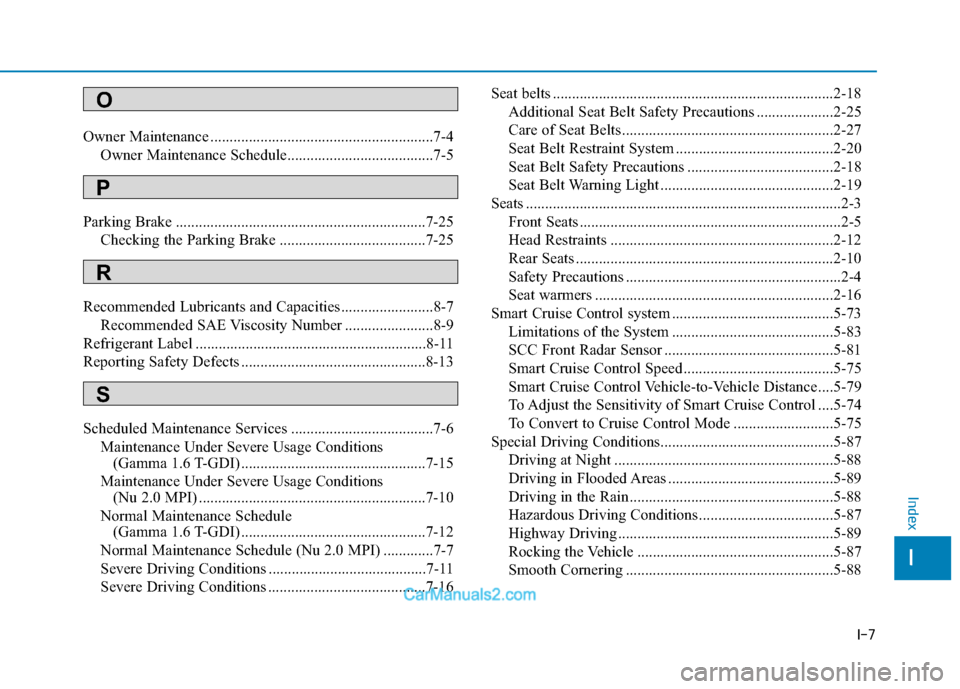2018 Hyundai Elantra capacities
[x] Cancel search: capacitiesPage 436 of 526

7-18
Maintenance
Automatic Transmission Fluid
(if equipped)
Automatic transmission fluid should not
be checked under normal usage condi-
tions. But in severe conditions, the fluid
should be changed at an authorized
HYUNDAI dealer in accordance to the
scheduled maintenance at the beginning
of this chapter.
Automatic transmission fluid color is
basically red.
As the vehicle is driven, the automatic
transmission fluid will begin to look
darker. This is a normal condition and
you should not judge the need to
replace the fluid based upon the
changed color.
Dual Clutch Transmission
Fluid (if equipped)
Inspect the dual clutch transmission fluid
according to the maintenance schedule.
Manual Transmission Fluid
(if equipped)
Inspect the manual transmission fluid
according to the maintenance schedule.
Brake Hoses and Lines
Visually check for proper installation,
chafing, cracks, deterioration and any
leakage. Replace any deteriorated or
damaged parts immediately.
Brake/Clutch Fluid
Check brake/clutch fluid level in the
brake/clutch fluid reservoir. The level
should be between the MIN and the MAX
marks on the side of the reservoir. Use
only hydraulic brake/clutch fluid conform-
ing to DOT 3 or DOT 4 specification.
Parking Brake
Inspect the parking brake system includ-
ing the parking brake pedal and cables.
Brake Discs, Pads, Calipers
and Rotors
Check the pads for excessive wear, discs
for run out and wear, and calipers for fluid
leakage.
Exhaust Pipe and Muffler
Visually inspect the exhaust pipes, muf-
fler and hangers for cracks, deterioration,
or damage. Start the engine and listen
carefully for any exhaust gas leakage.
Tighten connections or replace parts as
necessary.
Suspension Mounting Bolts
Check the suspension connections for
looseness or damage. Retighten to the
specified torque.
Steering Gear Box, Linkage &
Boots/Lower Arm Ball Joint
With the vehicle stopped and the engine
off, check for excessive free-play in the
steering wheel. Check the linkage for
bends or damage. Check the dust boots
and ball joints for deterioration, cracks, or
damage.
Replace any damaged parts.
Drive Shafts and Boots
Check the drive shafts, boots and clamps
for cracks, deterioration, or damage.
Replace any damaged parts and, if nec-
essary, repack the grease.
Air Conditioning Refrigerant
Check the air conditioning lines and con-
nections for leakage and damage.
NOTICE
The use of a non-specified fluid
could result in transmission mal-
function and failure. Use only the
specified automatic transmission
fluid (refer to "Recommended
Lubricants and Capacities" in
chapter 8).
CAUTION
Page 438 of 526

7-20
Maintenance
Use only the specified engine oil
(refer to "Recommended Lubricants
and Capacities" in chapter 8).
Checking the Engine Oil and
Filter
Have engine oil and filter changed by an
authorized HYUNDAI dealer according to
the Maintenance Schedule at the begin-
ning of this chapter.
NOTICE
CALIFORNIA PROPOSITION 65
WARNING
Engine oil contains chemicals
known to the State of California to
cause cancer, birth defects and
reproductive harm. Used engine oil
may cause irritation or cancer of
the skin if left in contact with the
skin for prolonged periods of time.
Always protect your skin by wash-
ing your hands thoroughly with
soap and warm water as soon as
possible after handling used oil.
WARNING
OAD076122
OAD075063L
■1.6 T-GDI
■2.0 MPI
Page 442 of 526

7-24
Maintenance
W
WA
AS
SH
H E
ER
R
F
F L
LU
U I
ID
D
Do not allow brake/clutch fluid to
contact the vehicle's body paint, as
paint damage will result.
Brake/clutch fluid, which has been exposed to open air for an extended
time should NEVER be used as its
quality cannot be guaranteed. It
should be disposed of properly.
Do not use the wrong kind of brake/clutch fluid. A few drops of
mineral based oil, such as engine
oil, in your brake/clutch system can
damage brake/clutch system parts.
Information
Use only the specified brake/clutch fluid
(refer to "Recommended Lubricants and
Capacities" in chapter 8).
Checking the Washer Fluid
Level
Check the fluid level in the washer fluid
reservoir and add fluid if necessary. Plain
water may be used if washer fluid is not
available. However, use washer solvent
with antifreeze characteristics in cold cli-
mates to prevent freezing.i
NOTICE
OAD075011
To prevent serious injury or death,
take the following safety precau-
tions when using washer fluid:
Do not use engine coolant or
antifreeze in the washer fluid
reservoir.
Engine coolant can severely
obscure visibility when sprayed
on the windshield and may cause
loss of vehicle control resulting
in an accident or damage to paint
and body trim.
Do not allow sparks or flame to
contact the washer fluid or the
washer fluid reservoir. Washer
fluid may contain alcohol and can
be flammable.
Do not drink washer fluid and
avoid contact with skin. Washer
fluid is harmful to humans and
animals.
Keep washer fluid away from chil-
dren and animals.
WARNING
Page 505 of 526

888
Specifications & Consumer information
8
Specifications, Consumer information and Reporting safety defects
8
Dimensions ..............................................................8-2
Engine ......................................................................8-\
2
Bulb Wattage ..........................................................8-3
Tires and Wheels ...................................................8-5
Volume and Weight ................................................8-6
Air Conditioning System........................................8-6
Recommended Lubricants and Capacities ..........8-7
Recommended SAE Viscosity Number .........................8-9
Vehicle Identification Number (VIN) .................8-10
Vehicle Certification Label .................................8-10
Tire Specification and Pressure Label .............8-11
Engine Number .....................................................8-11
Refrigerant Label .................................................8-11
Consumer Information .........................................8-12
Reporting Safety Defects ...................................8-13
Page 524 of 526

I-7
Owner Maintenance ..........................................................7-4Owner Maintenance Schedule......................................7-5
Parking Brake .................................................................7-25 Checking the Parking Brake ......................................7-25
Recommended Lubricants and Capacities ........................8-7 Recommended SAE Viscosity Number .......................8-9
Refrigerant Label ............................................................8-11
Reporting Safety Defects ................................................8-13
Scheduled Maintenance Services .....................................7-6 Maintenance Under Severe Usage Conditions (Gamma 1.6 T-GDI) ................................................7-15
Maintenance Under Severe Usage Conditions (Nu 2.0 MPI) ...........................................................7-10
Normal Maintenance Schedule (Gamma 1.6 T-GDI) ................................................7-12
Normal Maintenance Schedule (Nu 2.0 MPI) .............7-7
Severe Driving Conditions .........................................7-11
Severe Driving Conditions .........................................7-16 Seat belts ........................................................................\
.2-18
Additional Seat Belt Safety Precautions ....................2-25
Care of Seat Belts .......................................................2-27
Seat Belt Restraint System .........................................2-20
Seat Belt Safety Precautions ......................................2-18
Seat Belt Warning Light .............................................2-19
Seats ........................................................................\
..........2-3 Front Seats ....................................................................2-5
Head Restraints ..........................................................2-12
Rear Seats ...................................................................2-10
Safety Precautions ........................................................2-4
Seat warmers ..............................................................2-16
Smart Cruise Control system ..........................................5-73 Limitations of the System ..........................................5-83
SCC Front Radar Sensor ............................................5-81
Smart Cruise Control Speed .......................................5-75
Smart Cruise Control Vehicle-to-Vehicle Distance ....5-79
To Adjust the Sensitivity of Smart Cruise Control ....5-74
To Convert to Cruise Control Mode ..........................5-75
Special Driving Conditions.............................................5-87 Driving at Night .........................................................5-88
Driving in Flooded Areas ...........................................5-89
Driving in the Rain .....................................................5-88
Hazardous Driving Conditions ...................................5-87
Highway Driving ........................................................5-89
Rocking the Vehicle ...................................................5-87
Smooth Cornering ......................................................5-88
I
Index
O
P
R
S